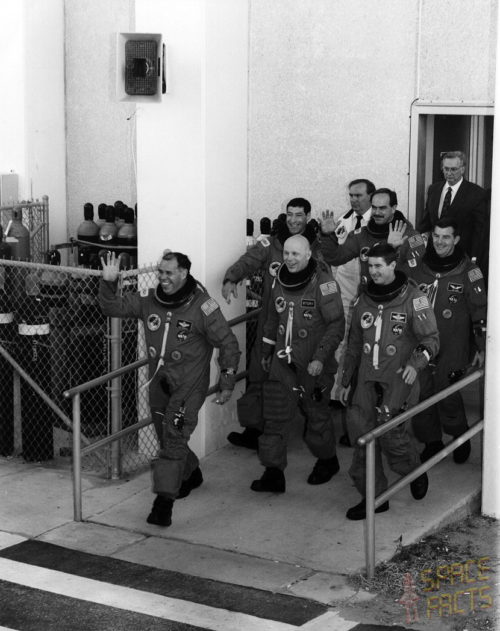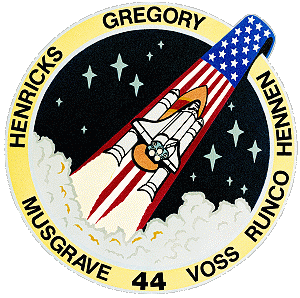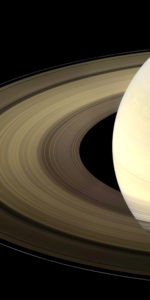
A quarter-century has now elapsed since a space shuttle mission was forced to come home early, having already lost its original commander and gained a professional U.S. Army imagery analyst as a crew member. In November 1991, Atlantis and her six-strong STS-44 crew—Commander Fred Gregory, Pilot Tom Henricks, Mission Specialists Jim Voss, Story Musgrave, and Mario Runco, and Payload Specialist Tom Hennen—supported the deployment of a Defense Support Program (DSP) infrared early-warning satellite, as well as a multitude of military experiments. However, the failure of a critical piece of navigational equipment forced their 10-day voyage to be shortened and Atlantis returned to Earth after a week in orbit. Still, STS-44 retains a place as one of the longest Department of Defense-dedicated shuttle flights ever completed.
When its crew was named in May 1990, the original commander was veteran astronaut Dave Walker, one of NASA’s most competent pilots. He had already piloted Mission 51A in November 1984, which successfully captured the errant Palapa-B2 and Westar-VI communications satellites, before commanding STS-30 in May 1989 to deploy the shuttle’s first planetary payload, the Magellan Venus radar-mapper. Unfortunately, in the days after STS-30, Walker had been flying from Houston, Texas, to Washington, D.C., in a NASA T-38 Talon jet, when he inadvertently passed close to a Pan Am commercial airliner. The near-miss was subsequently attributed to an air-traffic control error, but the episode and other “infractions of NASA flying rules” prompted a decision to temporarily revoke Walker’s T-38 flight status. A 60-day period of grounding came into force in July 1990, shortly after he was assigned to command STS-44. Since all shuttle pilots needed to be on current T-38 status, the decision cost him the mission and he was replaced by another veteran, Fred Gregory.

As the first African-American spacecraft commander, Gregory was excited not only by his unexpected assignment, but also by the fact that it would be aboard another shuttle orbiter. His first mission, in April 1985, had seen him pilot Challenger, whilst his second, in November 1989, saw him command Discovery. With the STS-44 flight aboard Atlantis, he would have flown three of NASA’s five-strong fleet of shuttles. “Each of these ladies,” he said of the three vehicles, “had slightly different personalities. You could get inside and hear things on one that you wouldn’t hear on the other, but Discovery and Atlantis were very close to each other. Challenger was a little earlier and so it had some slightly different characteristics.” By the time of his assignment to STS-44, Gregory was already thinking about how to close his astronaut career, and one option was to fly each of the five orbiters, including Columbia and Endeavour. “That would be a reason to stop flying,” he told the NASA oral historian, “so this one just kinda fit right into the scheme. I was pretty excited about it.” As events transpired, STS-44 would be Gregory’s final mission.
At the time of the initial crew assignment with Walker in command, the flight was scheduled to fly in March 1991, but shuttle program delays through the summer of 1990 caused it to slip to the right, eventually settling on a date in August 1991. This target also proved untenable, when Shuttle Discovery’s STS-39 mission was extensively postponed, throwing the remaining manifest for 1991 into disarray. Atlantis picked up Discovery’s STS-43 flight and correspondingly her STS-44 mission moved yet further to the right, eventually to November 1991.
With Gregory embarking on his third shuttle mission, and Musgrave his fourth, the pair thus guided a group of “rookie” astronauts through more than a year of training. In time, Tom Henricks would go on to become the first astronaut to log more than 1,000 hours as a space shuttle pilot or commander, whilst Jim Voss lived and worked for months aboard the International Space Station (ISS) and Mario Runco’s remarkable career saw him move from state police trooper to U.S. Navy meteorologist to astronaut and spacewalker.
Yet with Gregory in command, levity was a certainty. “The commander is responsible for the success of the mission,” he explained. “That’s a given. A secondary role for the commander is to ensure that the crew has had fun.” Like a family—though “not a dysfunctional family,” Gregory cautioned—a shuttle crew learned over time to accept its own strengths and weaknesses, in which no single member became overly headstrong and the skills of each astronaut worked harmoniously with the rest. In précis, he concluded, “a good crew is like a ballet … it’s musical in some ways and it’s very co-ordinated and beautiful.”
Launching so soon after Halloween gave the STS-44 crew an opportunity to stage a few pranks. “The word had gotten around,” Runco told a Smithsonian interviewer, years later, “that our crew was a little playful and somewhat irreverent—not what one would expect from a crew with only two veterans and four rookies.” A few months before launch, a memo had circulated in the astronaut office and came to be nicknamed “The Hair Memo.” Its content surrounded an incident in which astronaut Marsha Ivins had allowed her long hair to float freely on an earlier mission. NASA management feared that this could prove dangerous and had directed that hair was to be tied up.
Thankfully, the STS-44 crew included bald-headed Musgrave and Fred Gregory decided it would be fun to walk out for their Terminal Countdown Demonstration Test (TCDT) … with no hair. Runco and Voss bought some rubberized latex head coverings and five pairs of aviator-style sunglasses, like those worn by Musgrave, together with a handful of Story Musgrave name tags for their partial-pressure suits. When they walked out of the Operations and Checkout Building, it seemed to the gathered journalists that six Story Musgraves were emerging. …

“Six”, that is, because STS-44 also included a unique final crewman: Tom Hennen, an Army chief warrant officer and a recognized expert in the fields of intelligence and surveillance. His task on the mission was to develop and operate a battery of experiments to assess the capabilities of professional imagery analysts to observe terrestrial targets from orbit. His payload, known as “Terra Scout,” included the Spaceborne Direct View Optical System (SPADVOS) and the Military Man in Space (M88-1). Hennen’s mission actually formed part of a broader umbrella of Department of Defense flights, which, in the pre-Challenger era, might have seen Air Force meteorologists, Army geologists, and geographers and Strategic Defense Initiative (SDI) physicists fly aboard the shuttle.
These plans formed part of the Department of Defense’s Space Test Program (STP) and encompassed not only Terra Scout, but also “Terra View,” using cameras and binoculars to observe ground-based targets, and “Terra Geode,” employing specialized equipment to assess terrain suitability for tactical movements of troops. In fact, some of the Terra View and Terra Geode work was actually carried out—by Jim Adamson during the classified STS-28 mission and by Kathy Sullivan during the Hubble deployment flight, STS-31—although plans to fly dedicated Army specialists aboard the shuttle for these two payloads never bore fruit. Similarly, a military Spacelab mission (known as “Starlab”) retained a place on the shuttle manifest until 1990, before budgetary support dried up and it was canceled.
For Fred Gregory, having Hennen aboard was something totally new. “We had never flown a military non-officer before and it was actually pretty exciting, because he was from the photo-interpretation field,” Gregory told the NASA oral historian. “I know many had talked about what you can actually see from space, suggesting that there may be a battlefield advantage of being in space and so, with Tom on board, he was the one who was going to come in and use whatever small optical devices he had to determine whether it was possible to do a good amount.”
At length, in November 1991, the six-strong crew of STS-44 was ready to embark on an almost-10-day voyage into space. Theirs was expected to be the longest Department of Defense shuttle mission in history. In fact, with a targeted duration of nine days and 19 hours, Atlantis’ 10th orbital flight promised to be her own longest to date, entering third place as the longest shuttle mission at that time.
Unfortunately, STS-44 did not quite turn out that way.
The second part of this article will appear tomorrow.
Be sure to “Like” AmericaSpace on Facebook and follow us on Twitter: @AmericaSpace
.





